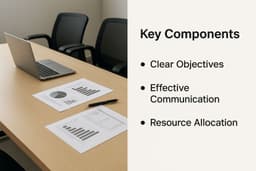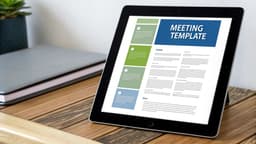
A meeting without proper minutes is like a file you forgot to hit ‘Save’ on— everyone leaves thinking progress was made, but hardly anything’s actually changed.
Good minutes aren’t just notes; they’re a blueprint for accountability. They show what was discussed, what decisions were made, and who’s on the hook for what. The problem? Without a proper format, minutes often dissolve into a jumble of half-remembered conversations and vague action points.
The fix? A good meeting minutes format sample to guide your note-taking.
This guide shows you exactly what that looks like, with examples you can plug into your own meetings today.
Why a Good Meeting Minutes Format Matters
Structure is what turns messy notes into a reliable record. It’s the difference between “I think we agreed on something like that…” and “Here’s what was decided, and here’s who owns it.”
And the numbers back it up:
- 64% of recurring meetings run without an agenda
- 71% of employees feel most meetings are unproductive
- Businesses lose $37 billion annually due to unproductive meetings
That gap creates wasted time, unclear follow-ups, and missed opportunities. A consistent minutes format fixes this by bringing order, focus, and accountability.
Core Components of a Professional Meeting Minutes Format

Every effective set of minutes shares a common backbone. Here are the essentials you should never skip:
| Section | Why It Matters |
| Header | Sets context with meeting title, date, time, and location. |
| Attendees | Records who was present, absent, or excused. |
| Agenda Topics | Outlines the flow of discussion, making notes easier to follow. |
| Decisions | Captures final calls to avoid second-guessing later. |
| Action Items | Assigns clear tasks, owners, and deadlines. |
Think of these as the building blocks of accountability. Leave one out, and the structure weakens.
Step-by-Step Guide to Writing Minutes

Here’s a step-by-step guide to writing great, highly effective meeting minutes:
Step 1: Start With the Basics
Begin with a header that sets the stage:
- Meeting title
- Date & time
- Location or link (if virtual)
This ensures context is never lost, even if someone revisits the minutes weeks later.
Step 2: Document Attendance
List everyone who attended, along with those absent or excused. This creates transparency and accountability.
- Example:
Present: John Doe, Jane Smith, Aisha Khan
Absent: Mark Liu (excused)
Step 3: Summarize the Agenda Topics
For every topic on the meeting agenda, write a brief, neutral summary. Avoid writing opinionated or lengthy summaries; just stick to the facts and keep it short and sweet.
Example:
Agenda Item 3: Review of Q4 Social Media Campaign Proposal
Discussion: The team went over the budget and timeline for the proposed campaign. Sarah Chen pointed out a concern with the ad spend for Platform X, suggesting we move some of that budget to Platform Y, citing recent performance data. John Smith backed this up, mentioning Platform Y's better engagement in Q3. The group then talked through the pros and cons of making that change.Tip: Use bullet-point summaries to keep things focused and easy to write.
Step 4: Record Final Decisions
End each agenda item with a clear decision statement. This is perhaps the most important part of your meetings.
If a vote was taken, include the results.
- Example:
- Decision: The team approved the proposal, with one change: reallocating 25% of the ad budget from Platform X to Platform Y.
- Next Steps: Sarah Chen is responsible for updating the budget to reflect this decision.Step 5: Assign Action Items
Action items keep projects moving by turning talk into tasks.
To be effective, each one needs a clear task, a single owner, and a firm deadline. Use strong, action-oriented wording (e.g., “Create five graphics” instead of “Social media”) and track them in a simple table for clarity and accountability.
Every task should include:
- What needs to be done
- Who is responsible
- When it’s due
Example action log:
| Task | Owner | Deadline |
| Draft press release for product launch | Jane Smith | Sept 20 |
| Finalize budget approval | John Doe | Sept 22 |
| Schedule client feedback session | Aisha Khan | Sept 25 |
For a more in-depth guide on how to take effective meeting minutes without hassle, check out the full guide.
The Complete Meeting Minutes Example

Here’s a good meeting minutes sample—that follows the guide above—you can easily adapt to your own meetings:
Meeting Title: Weekly Project Sync
Date & Time: Monday, Sept 8, 2025 – 10:00 AM
Location: Zoom
Attendees: Sarah (PM), John (Dev Lead), Maria (Designer), Alex (QA)
Absent: James (Content)
Agenda Item 1: Homepage Redesign
- Discussion: Discussed current wireframe updates.
- Decision: Maria to finalize design by Sept 15.
Agenda Item 2: Backend API Rollout
- Discussion: John confirmed deployment is scheduled for Sept 12. Alex raised the need for post-deployment regression testing.
- Decision: Alex to run regression tests post-deployment.
Action Items:| Task | Owner | Deadline |
|---|---|---|
| Finalize homepage design | Maria | Sept 15 |
| Run regression tests after rollout | Alex | Sept 12 |
Here’s the meeting minutes format sample as a template so you can get started with it quickly:
Meeting Minutes Template
Here’s the meeting minutes format sample as a template so you can get started with it quickly:
Meeting Title: [Insert meeting title]
Date & Time: [Insert date & time]
Location: [Insert location or link]
Attendees: [List attendees]
Absent: [List absentees, if any]
Agenda Item 1: [Insert topic]
• Discussion: [Brief summary of discussion points]
• Decision: [Final decision or outcome]
Agenda Item 2: [Insert topic]
• Discussion: [Brief summary of discussion points]
• Decision: [Final decision or outcome]
Agenda Item 3: [Insert topic]
• Discussion: [Brief summary of discussion points]
• Decision: [Final decision or outcome]
Action Items:| Task | Owner | Deadline |
|---|---|---|
| [Describe task] | [Name] | [Date] |
| [Describe task] | [Name] | [Date] |
| [Describe task] | [Name] | [Date] |
Optimizing Your Documentation Process

Writing minutes doesn’t need to be a burden. A few habits can save you hours:
- Use a template — a good meeting minutes format speeds up the process and keeps consistency.
- Draft in real-time during the meeting — don’t wait until after. Learn how to take better meeting notes.
- Keep it concise — summaries beat verbatim notes.
- Share promptly — delayed minutes lose impact.
Fun fact: 50% of the effort often goes into just distributing the minutes. That’s a huge chunk of time! It underscores why nailing the format from the very beginning is so critical — it makes the final document clear, concise, and ready to send without a ton of extra work.
Questions? Here Are Some Quick Answers.
Q: How detailed should minutes be?
Enough to capture outcomes and responsibilities, not every word said.
Q: Who should take the minutes?
Ideally, a neutral participant (often the project manager or designated scribe).
Q: Do all meetings need minutes?
No — but any meeting involving decisions, deadlines, or cross-team work does.
For more FAQs and answers, check our full FAQ guide on meeting minutes.
Next Steps
Good minutes drive the future by being the source of truth for what next in pushing towards a business’ goals.
Start with the template above, adapt it to your team’s needs, and watch how quickly accountability and productivity improve!


